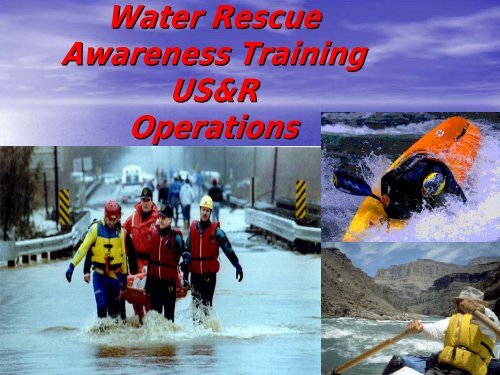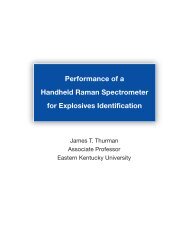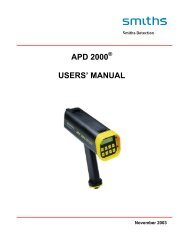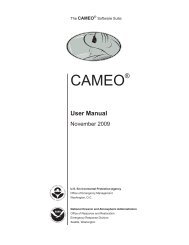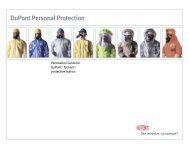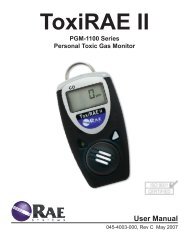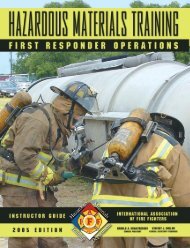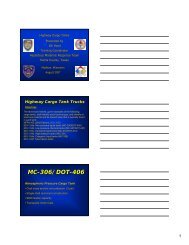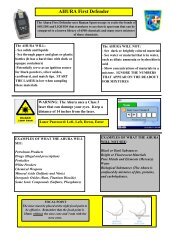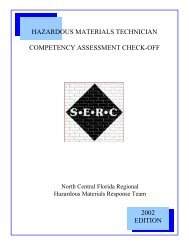Click here for training program - Mitf1.us
Click here for training program - Mitf1.us
Click here for training program - Mitf1.us
- No tags were found...
Create successful ePaper yourself
Turn your PDF publications into a flip-book with our unique Google optimized e-Paper software.
Water RescueAwareness TrainingUS&ROperations
Course Introduction• Floods mostdestructive of naturalcatastrophes• Kills more people thanany other <strong>for</strong>m ofdisaster• Rescue capabilitylimited and usually anafterthought
Earth is 80%Water
Course Objectives• Provide potentialrescue personnelawareness level<strong>training</strong>• Students willunderstand t<strong>here</strong>sponsibility ofawareness levelresponders to waterrescue situations• Students willrecognize a waterrescue situation andunderstand the risksassociated withper<strong>for</strong>ming waterrescue
More Dangerous thanmost <strong>for</strong>ms of rescue!Moving Water killsmoreAmericans each yearthan fires.
Moving water is powerful
Deaths by drowning• Firefighters 7 since 1999• Police Officers 22 since 1995• Children 1-14114 second leading cause ofdeath > 900 per year• 112 drowning deaths per year in Washington• Second leading cause of death to 15-19 19 yearolds in Washington
Definition of “swiftwater“swiftwater”……faster than _____ 1.5 mph
NFPA 1670 standards• Adopted 1998• Covers all specialrescue disciplines• Establishes guidelines<strong>for</strong> AHJ to identifyhazards, determinelevels of <strong>training</strong>, andresponse sop’s• *Water rescue• *Rope rescue• Confined Space• Wilderness SAR• Trench• Structural Collapse• Vehicle andmachinery rescue
Three levels of capability• Awareness• Operations• Technician
AwarenessMinimum capability <strong>for</strong>any responder Whomay, during regularduties, respond totechnical rescueincidentsNot considered“rescuer”• Scene assessment &size up• Risk Vs. Benefit• Resource ordering• Site control & ICS• Hazard recognitionand avoidanceprocedures
Operations• Hazard recognition• Equipment use• Shore & boat basedrescue skills• Assist technician levelrescuers• Low risk tactics• PPE required• Self rescue skills• Victim packaging
Technician• Hazard recognition• Equipment use• Coordination skills• Per<strong>for</strong>m andsupervise technicalrescues• Search, rescue andrecovery operations
Agency Having JurisdictionNFPA requirements• BLS is minimal medical care• Establish procedures consistent with chosen level ofoperations• Provide <strong>training</strong> commensurate with operation level• Provide continuing education and per<strong>for</strong>manceevaluations• Maintain <strong>training</strong> documentation• Have personnel accountability system
Special RescueAny incident w<strong>here</strong> a personis stranded, trapped,injured or killed and skillsand equipment that arenot normally availablewith first responders areneeded to safely rescueor recover the victim.
Examples of Special Rescue• Water, ice, river rescue• High angle• Confined space• Hazmat• Trench• Wilderness• Structural collapse
Awareness Level Responders“If you do not have theskills, If you do nothave the equipment,If you do not havethe knowledge, youshould not attemptthe rescue!”
Awareness Level Response• Identify the problem• Stabilize the situation• Prevent it from getting any worse• Call the appropriate resources and getthem enroute
Rescue Priority• All rescue personnelmust be prepared to:– Self rescue– Back up and rescueteam members– Rescue the subjectonly when safety ofthe rescuers ismaximized• “Self sacrifice istraditional andcommendable----and auseless waste”
14 absolute rules ofswiftwater rescue• Always wear a PFD• Deploy upstreamspotters• Self, team, victim• Have a backup plan• Downstream backup• Keep it simple• Use the right gear• Be proactive• Never put feet down• Don’t rely on victim• Never tie a rope to arescuer• Never tension a line90° to current• Never lose a victimonce contacted• No fire helmets
Successful Rescue• Training• Experience• Practice• Judgement“Training is not enough.Practice andExperience are vital inorder <strong>for</strong> the rescueleader to makecorrect Judgments”
Self Rescue & Personal Safety• Awareness– Understand the dangers• Capability– Strength and equipment– Improved ability to survive• Knowledge– Have a plan,– Know what to do– Know how to do itKnowledgeAwarenessCapability
Common characteristics offailed rescues• Good people• Good intentions• Poor <strong>training</strong>, no <strong>training</strong>• Wrong equipment• Failed to recognize hazards• Failure to evaluate Risk Vs Benefit
Site Control‣ Hot Zone –• “The Water”• Technicians only
Site Control‣ Warm Zone –• Within 10 feet of the water• Within a Rescue Craft• For Operations, Techs only
Site Control‣ Cold Zone –• Outside of the Hot or WarmZones• Awareness Level• Family & Bystanders
Determine if rescue or bodyrecovery
Obtain Witness StatementsxActual
River Search Tactics• Hasty Search• Evaluate the river• Likely spots• River banks / Clues• Obstructions
Determinerescue methodinvolving theleast risk…
Identify Specific Hazards‣ Low head dams = Drowning machines.
Boil Boil Line LineBackwashOutwashEscape Route
CurrentLow head dam – Boil lineCurrent
Training exercise gone badRescuers entered past boil line and couldNot get back out
Second rescue boat attempted to pull first out using a throw bagCurrent directions
Pulling against the current caused orange boat to swampMaking a bad situation worseCurrent direction
current
Second boat enters past boil line toRescue the two in trouble placing allfour at risk.White water and current workAgainst the efficiency ofA water jet that powers the gray watercraftSolution was <strong>for</strong> the rescuer in the stern of theorange boat to get to the bow of the orange boat,get it turned the opposite direction and pull it outbow first not stern first with the gray boat.This second ef<strong>for</strong>t would have been successful but pullingfrom the stern again was doomed to fail
Gray craft is now facing into the dammoving with the current in white waterWhitewater is full of air which = less floatationand is less efficient <strong>for</strong> water jets or props
The driver of the gray water craftDoes not survive this error!
Was this necessary?Was this preventable?
The river is 8 feet above flood stage!This was a <strong>training</strong> event!Judgment?
The equipment was not adequateFor the environment and <strong>for</strong>ce and powerOf the water.Rescuers failed to recognize the limitationof their equipment or the best way to use it.
Proper PPE did provide additional capabilityand increased survivability allowing three of the fourTo survive long enough to be rescued.
Good peopleGood intentions, misplaced judgmentUsed good equipment in wrong wayFailed to recognize All of the hazardsFailure to evaluate Risk Vs Benefit
Survived because theyWere Aware, stayed with boatsHad Knowledge, worked togetherWere Capable, All were strong and wore PPE
What went wrong?
Advanced Hazards requireadvanced rescue skills‣ StrainersAnything in the currentthat will trap swimmer or boatTrees, fences, rocks etc.
Man made hazards
‣ FootEntrapmentNatural HazardsWhen wading, crossing astream or river, if youentrap a part of yourbody, the <strong>for</strong>ce of thecurrent can <strong>for</strong>ce youunder and hold you t<strong>here</strong>.Debris, rocks, fences, etccan snag and hold aperson and not allowthem to float to thesurface w<strong>here</strong> rescue ispossible
Reoccurring hazards‣ Vehicles‣Low lying roads‣Wash or urban storm drains
Flood Situations• Two feet of water willfloat the average car• Do not drive over aflooded roadway• Nearly half of all floodrelated deaths occur invehicles.• The underlying roadbedmay be washed out• If the roadway waselevated, you could bewashed into a lowheadwall dam, or“drowning machine.”
Identify Specific Hazards‣ All flood waters shouldbe considered to beContaminated Water
Waterfalls
‣ Hypothermia• Still water steals heataway from the body 25times as fast as still airCold Water• A 5 mph currentincreases this to 250x•“Hypothermic debility”
Cold Water Shock• Accounts <strong>for</strong> dozens of fatalities each year• Occurs in water 32 - 50 degrees• Leads to the principal cause of death– Drowning– Hypothermia– Heart attack
Memorial Day Weekend 2005Western Washington statistics• 6 drowning deaths in 24 hours• 90 degree air temperature• 50 degree water temperature• 1 rescuer died• Deaths occurred in Lakes, rivers and inPuget Sound
Drowning deaths, Memorialday Washington 2005• W/M 40, Drove into Snohomish river• W/M 13, Swimming in Green River• W/F 13, Cedar River, Rescue attempt– Attempted rescue of friend, friend survived• W/M 24, Swimming in Snoqualmie River• W/M 28, Jumped from boat in Lake Wash• W/F 12, Silver lake, Rescue attempt– Attempted rescue of cousin, Cousin drowned• W/F 10, Swimming in Silver lake
Major Obstacles• Reduced ability to hold breath– Average less than 15 seconds• Rapid numbing of extremities• Rapid loss of coordination, grip strength,motor skills• Death from hypothermia 20 to 30 timesfaster than air
Reflex actions• Involuntary gasp reflex– Aspiration of cold water– Laryngospasms• Hyperventilation– Respiration increases up to five times• Sudden heart rate acceleration
Rules of 50• An average adult has 50% chance ofsurviving a 50 yard swim in 50° water• A 50 year old person in 50° water has a50% chance of surviving <strong>for</strong> 50 minutes
Identify SpecificHazards‣ Hypothermia• Wind-chill factorincreases significantlywhen person is wet• Increases even morewhen immersed in movingwater
Boats, Pros & cons• Motorized boats– Engines fail• Airboats– Not meant <strong>for</strong> rivers• PWC– Limited crew and passengercapacity• Hovercraft– Expensive, loud, crewlimitations, extensive <strong>training</strong>• Inflatable rafts– Requires multiple trained crew• Kayaks– Limited rescue capability– Good scout craft• Rigid Hull Inflatable's (RHI)– Best choice, multiple uses– Requires crew managementand <strong>training</strong>
Request AdditionalResources
Request AdditionalSCUBAResources
Search and Rescue SCUBA isHigh Risk• Few actual rescues• Rescue of fellow teammembers more likely• Black Water• Cold water• Contaminated Water• Confined Space Dive• Moving water
SCUBA in moving water• Physically fit• Very strong swimmer• Experienced• Self rescueknowledge• Swiftwater trained
Minimum Training <strong>for</strong>SCUBA in Swiftwater• SRT I & SRTA• Advanced open waterSCUBA• Dive Rescue I
Moving water is Powerful• Powerful• Relentless• Predictable• Flow is measured inCubic Feet/Sec (CFS)• Water speed doubles,<strong>for</strong>ce increases X 4– 40 lbs psi @ 4mph– 160 lbs psi @ 8mph
Moving water is predictableif you understand RiverDynamicsEddyxWater moves over, around and throughobjects in a predictable manner• Every obstruction creates an eddy• Every constriction creates an increase inwater speed.Downstream vxxX = throwbaglocationstrainer
Example of the power of moving water
Any floating object that stopsAgainst a stationary objectWill be pulled under by the current
If you are lucky enough tonot be caught by obstructionsyou may pop back to the surface
River loads• Bottom loadAnything that movesalong the bottom with thecurrent• Suspended loadAnything that is suspended inthe water but is not floating onthe surface• Surface loadAnything that floats on thesurface
Terminology• Hydraulic– Water flowing over an object• Eddy– Reverse flow of water aroundan object• Eddy fence– Line between two oppositecurrent flows• Hole, stopper, keeper– Large hydraulic capable ofholding a swimmer or a boat• Standing wave– Created downstream of anunderwater object• Strainer– Bad place <strong>for</strong> a swimmer or aboat to be• Frowning hole– Hard to escape from• Smiling hole– Easier to escape from• Downstream V– Fastest moving water, usuallybest route throughobstructions• Upstream V– Indicates something under thewater• Cushion– Created upstream of an object• Confluence– Point w<strong>here</strong> two convergentcurrents meet
DOWN RIVERCurrentRiver RightDirections arealways givenwhile lookingdown river.River LeftUP RIVER
River Categories• Class I• Class II• Class III• Class IV• Class V• Class VI• Moving, few riffles• Waves up to 3’• Complex waves & maneuvering• Difficult, long rapids• Serious risk of injury• Nearly impossible, very dangerous
HydraulicsCalm watersCushionStanding wavesEddy
Hydraulic, Hole, KeeperReaction waveEddy
Lowheadwall dam,Boil lineManmadestructure
• Use extremecaution if tyingropes aroundrescuers in swiftwater operationsA rope tied to a swimmer and securedOn shore will cause the swimmer to be pulledunderwater and held t<strong>here</strong>.The swimmer must be trained and capable of releasing the line whenIt is no longer an aid to them or they will drown!
Leave the TechnicalRescue to the“Technicians!”
TESTUse the included test toanswer your questions andreturn by e-mail eor fax.
1. True or False• A person trained at the awareness levelshould not enter the water to conductrescue operations.
2. True or False• Moving water is any water that movesfaster than 1.5 mph and is one of themost dangerous <strong>for</strong>ms of rescue that canbe undertaken.
3. At the scene of a missing personin a lake, A person trained at theawareness level should do all of thefollowing except whatA. Identify the problemB. Stabilize the situationPrevent it from getting any worseC. Prevent it from getting any worseD. Call the appropriate resources and getthem enrouteE. Put on a PFD and get in a boat to helplocate the point the victim was last seen.
4. Rescue priority should be in whatorder?A. Self rescueBack up and rescue team membersRescue the subjectB. Back up and rescue team membersSelf rescueC. Rescue the subjectD. Rescue the subjectE. Self rescueBack up and rescue team members
5. List the order of rescuefrom least to greatest riskGo, Throw, Reach, Tow, Helo, , RowReach, Throw, Row, Tow, Go, HeloGo, Tow, Helo, , Throw, Reach, RowD. Helo, , Row, Reach, Throw, Tow, GoA. Go, Throw, Reach, Tow,B. Reach, Throw, Row, Tow, Go,C. Go, Tow,
6. True or False• The current just below a low head walldam is actually flowing back up streamtowards the face of the dam!
7. Which of the following iscorrectA. Two feet of water will float the average carB. Do not drive over a flooded roadwayC. Nearly half of all flood related deaths occur invehicles.D. The underlying roadbed may be washed outE. If the roadway was elevated, you could bewashed into a low headwall dam, or “drowningmachine.”F. All of the aboveF.
8. True or FalseCold water shock accounts <strong>for</strong> dozens offatalities each year and occurs in water 32- 50 degrees
9. Which of the following iscaused by cold waterA. Reduced ability to hold breath• Average less than 15 secondsB. Rapid numbing of extremitiesC. Rapid loss of coordination, grip strength,motor skillsD. Death from hypothermia 20 to 30 timesfaster than airE. All of the above
10.True or False• A floating object such as a boat orswimmer will be <strong>for</strong>ced under water bymoving water if it comes up against animmovable object such as a bridge or astrainer.


